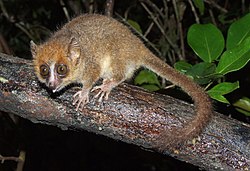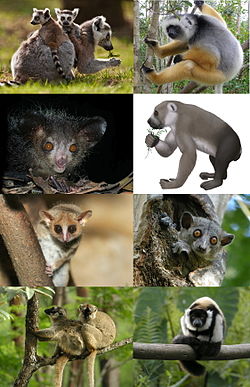Prosimians are a group of primates that includes all living and extinct strepsirrhines (lemurs, lorisoids, and adapiforms), as well as the haplorhine tarsiers...
13 KB (1,275 words) - 23:35, 8 February 2025
diagram, the strepsirrhine/prosimian clade, is basal to the hominoids/ape clade. In this example, both Haplorrhine as prosimians should be considered as...
16 KB (1,750 words) - 14:09, 13 May 2025
leading to humans. Commonly used names for groups of primates such as prosimians, monkeys, lesser apes, and great apes reflect this methodology. According...
162 KB (16,891 words) - 22:05, 19 May 2025
living primates have lost at least the first premolar. "Hence most of the prosimians and platyrrhines have three premolars. Some genera have also lost more...
39 KB (3,652 words) - 19:44, 15 April 2025
would be quite unlikely. Despite this preferred taxonomic division, "prosimian" is still regularly found in textbooks and the academic literature because...
22 KB (1,884 words) - 17:06, 27 April 2025
identified in prosimian fossils from as early as the Eocene. Vertical clinging and leaping has only been observed in primates, and primarily in prosimians. A few...
14 KB (1,557 words) - 04:26, 15 November 2021
biology, behavior, and health of primates. Mouse lemurs are categorized as prosimian primates. They are among the smallest and most rapidly developing primates...
16 KB (1,510 words) - 01:27, 17 December 2024
In 1966, a prosimian colony of approximately 90 individuals, belonging to John Buettner-Janusch, was relocated from the Center for Prosimian Biology at...
9 KB (863 words) - 18:29, 17 May 2025
Dixson (26 January 2012). Primate Sexuality: Comparative Studies of the Prosimians, Monkeys, Apes, and Humans. Oxford University Press. ISBN 978-0-19-954464-6...
7 KB (750 words) - 05:43, 25 January 2025
Dixson, Alan F. (1998). Primate Sexuality: Comparative Studies of the Prosimians, Monkeys, Apes, and Human Beings. Oxford, England: (Oxford University...
56 KB (6,229 words) - 05:15, 3 April 2025
a small brain-to-body mass ratio. Additional traits shared with other prosimian primates (strepsirrhine primates and tarsiers) include a bicornuate (two-horned)...
175 KB (18,681 words) - 06:25, 3 April 2025
Dixson, A. F. (2012). Primate Sexuality: Comparative Studies of the Prosimians, Monkeys, Apes, and Humans. OUP Oxford. ISBN 978-0-19-150342-9. Goodall...
122 KB (13,236 words) - 03:57, 11 May 2025
absence of a fourth cusp, the hypocone, distinguishes it from various other prosimian primates. ? Nycticebus linglom was described in 1997 by French paleontologists...
7 KB (805 words) - 04:30, 12 January 2025
ISBN 978-0-309-05233-7. Retrieved 5 July 2011. Izard, M. Kay (2006). "Nursery-reared Prosimian Primates". In Sackett, Gene P. (ed.). Nursery rearing of nonhuman primates...
18 KB (2,172 words) - 11:20, 19 March 2025
Archived from the original on July 16, 2015. Retrieved November 14, 2014. "Prosimian Personalities — Jovian". Duke Lemur Center. September 25, 2011. Retrieved...
8 KB (533 words) - 20:42, 29 April 2025
ISBN 978-1-4129-5846-2. Dixson A.F. (2012) Primate sexuality: Comparative studies of the Prosimians, Monkeys, Apes, and Human Beings. Oxford University Press, 2nd edition...
168 KB (18,329 words) - 21:31, 16 May 2025
subregions for different complex movements in posterior parietal cortex of prosimian galagos". Proceedings of the National Academy of Sciences of the United...
17 KB (1,895 words) - 18:08, 27 April 2025
2018. A. F. Dixson (2012). Primate Sexuality: Comparative Studies of the Prosimians, Monkeys, Apes, and Humans. Oxford University Press. ISBN 978-0199544646...
136 KB (14,608 words) - 05:01, 19 May 2025
Hasegawa, M.; Horai, S. (2009). "Molecular phylogeny and evolution of prosimians based on complete sequences of mitochondrial DNAs". Gene. 441 (1–2): 53–66...
82 KB (8,895 words) - 04:05, 20 May 2025
Approximately 100 species of mammal are known to inhabit, or to have recently inhabited, the Korean Peninsula and its surrounding waters. This includes...
94 KB (4,447 words) - 03:31, 8 March 2025
Dixson (26 January 2012). Primate Sexuality: Comparative Studies of the Prosimians, Monkeys, Apes, and Humans. Oxford University Press. ISBN 978-0-19-954464-6...
45 KB (5,315 words) - 08:21, 17 May 2025
index that ranges from 63-66. It has a broader ribcage than most other prosimians, and has many lumbar vertebrae lending it considerable flexibility. The...
18 KB (2,124 words) - 16:48, 11 December 2024
or were anthropoids, so they form the clade called Anthropoidea. The "prosimians", on the other hand, form a paraphyletic taxon. The name Prosimii is not...
53 KB (5,610 words) - 16:02, 4 May 2025
Alan F. Dixson (2012). "Primate Sexuality: Comparative Studies of the Prosimians, Monkeys, Apes, and Humans". International Journal of Primatology. 34:...
53 KB (5,928 words) - 05:49, 15 February 2025
the subgroups defined for extent SIVs, two endogenous SIVs are found in prosimian lemurs. These paleo-SIVs form a basal branch relative to extant SIVs....
34 KB (3,294 words) - 02:51, 1 April 2025
phylogenetic position of tarsiers compared to both simians and the other prosimians. Tarsiers are most often placed in either the suborder Haplorhini with...
83 KB (8,591 words) - 19:39, 2 April 2025
monophyletic taxon: the simians (in yellow); a paraphyletic taxon: the prosimians (in cyan, including the red patch); and a polyphyletic group: the night-active...
11 KB (1,054 words) - 22:00, 12 May 2025
Dixson, Alan F. (2012). Primate Sexuality: Comparative Studies of the Prosimians, Monkeys, Apes, and Humans. Oxford University Press. ISBN 978-0-19-954464-6...
203 KB (18,404 words) - 08:37, 13 May 2025
(which cannot make vitamin C) and its sister suborder of non-tarsier prosimians, the Strepsirrhini ("wet-nosed" primates), which retained the ability...
147 KB (15,288 words) - 03:12, 21 May 2025
Dixson, Alan F. (2012). Primate Sexuality: Comparative Studies of the Prosimians, Monkeys, Apes, and Humans. Oxford University Press. p. 364. ISBN 978-0-19-954464-6...
16 KB (1,756 words) - 15:49, 9 May 2025
























